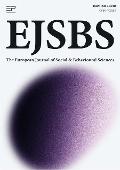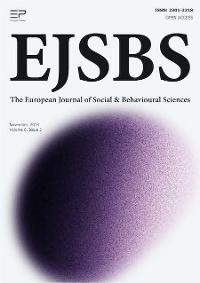Abstract
The purpose of this recent study is to create new, music technology-based solutions for orchestra learning and teaching. In the Playback Orchestra (PO) method, students learn their orchestra parts with the support of an auditory model: the playback of the full score. In a score written with a notation programme, the tempo, instrumentation and dynamic changes can easily be edited and the scores can be sent via email to the students to be printed, listened to and played. In this recent quasi-experimental study, the playing skills of the students were evaluated by video before and after the learning period by two professional violin teachers. The test group learned their orchestral parts by using the Playback Orchestra method and the control group played and studied music from printed copies. The aim was to determine whether playback has the intended effect on learning music. It was found that there were significant differences between the study groups in learning a first violin score of a chamber music composition. The communication skills, tonality-based intonation and expression of dynamic marks developed faster in the test group during the practice period.
Keywords: Technology-based learning, string instrument instruction, orchestra teaching, auditory models in learning
Introduction
Learning orchestra-playing skills is an important part of a violin student’s music education, because string instruments are essential to orchestras. In addition, to read music scores fluently, the player should follow the conductor, listen to others and, if he or she is the first violinist of a chamber music group, conduct others by playing. In other words, communication skills are needed as well.
According to research on Finnish orchestra students (Vartiainen, 1995), their attitudes towards playing together, orchestra conductors and the orchestra music itself are positive. Students meet their orchestra peers willingly and they say that they do not find their public performances as stressful as their solo performances. The students denote that in orchestra rehearsals they learn to listen to each other and improve their social interactions. Furthermore, they improve in reading music scores, keeping the pulse, generating nuances, and perceiving the larger picture of a piece of music. But only half of the students practised their scores at home. Perhaps playing printed scores without knowing much about the larger picture of the music is not motivating. That is why Juntunen (2011) created a home practice method, Playback Orchestra, which resembles an orchestra rehearsal situation; she has found it to be successful in orchestra teaching.
Orchestra skills develop in orchestra rehearsals in a natural way. Unfortunately, the music schools cannot afford orchestra teaching more than once a week at most. The students are left unsupervised in their home practice, and may be unmotivated to practice with their paper scores of second or third violin scores. They do not have a “big picture” of the music.
To support orchestra students` home practice, Juntunen et al. (2011) have developed the Playback Orchestra (PO) teaching method: the students practise their orchestra parts along with the playback of the full score of the music. Thus, they hear the entire orchestra while playing their own parts. They can have orchestra rehearsals in their own rooms as often as they wish.
According to Juntunen et al. (2011), for the youngest students, especially, it is important that the music they practise is appropriate, not too easy or difficult, nice and imaginative. Therefore, Juntunen (2011) has arranged and composed “tailor-made” pieces for her orchestras. Some of the pieces are orchestra etudes aimed at developing bowing technique, dynamics, articulation, and communication. Because notation programmes write the scores, the playback can be listened to immediately and the score corrected if there is something wrong. The digital files can be shared via the Internet and sent by email to the students to be printed, listened to, and played along with the playback. That is, they practise by the Playback Orchestra method at home.
The PO method is free and easy to use at home. Playing along with the playback gives the student the feeling of playing in an orchestra with peers. The player corrects mistakes while playing, because the playback gives the reference standard, a model of the correct performance for comparison. The student does not feel this feedback as negative because it is self-generated and occurs immediately. It is important that the student feels good in the learning situation, because that feeling can generate success in future musical encounters (Graham & Weiner, 1996, pp. 71–72). In a PO practice situation, a music student operates in open and emotionally safe conditions, without having to be afraid of the demolishing effects or criticism (see Sava, 1993, 29).
In the PO method, the student can practise the difficult sections repeatedly at a tempo that is suitable for his or her competencies. The main advantage of the notation programme playback over Play along CDs and other recorded media is that the tempo can be adjusted to the skills of the player, first slow, then faster. Additionally, the playback of a new composition is available immediately without any recording processes. It is quick, easy, and free of charge for the student.
Playback Orchestra practising is like diving into the flow: students catch the music, drop and then catch it again. They do not have to worry about dropping the music now and then or making mistakes. They learn to follow the music and conductor in a fluent way that is essential in orchestra learning.
Playing an instrument in an orchestra is like playing a game: a game has very strict rules and boundaries within to find ways to succeed and learn. A feeling of ‘flow’ develops that gives joy and extra energy to the player. As Csiksentmihalyi (1996) points out, at the centre of the game enjoyment there is an experience called “game flow” which is born when the idea of the game, the difficulty and the possibilities of the game are in balance with the player’s own skills building an intrinsic motivation (Csiksentmihalyi 1996).
The PO method does encourage students to develop a self-directed learning attitude, but what, in fact, is learned? Like dancing, playing music is a series of movements, proceeding in time and space. If students have the appropriate knowledge of how to adjust their movements to the details of the surroundings, they can anticipate what is to come next and learning the whole series of correct movements is fast.
Music students have learned how to react to marks on the music score: key, rhythmic patterns, notes and rests. As they play from the printed score, they can adjust their “steps in a music path” in much the same way as walking without seeing anything but the “path”. Anyway, musically talented and appropriately educated orchestra students gain an image of the whole music; especially if they have played the music in the orchestra before practising their parts alone at home. However, if students practise at home from the print and in addition hear the whole orchestra in the background, the whole process is like going on a path and “hearing” the surroundings as well. Perhaps it is a path going up and down a hill. They may get a bit lost, but if they have the “big picture” of their surroundings, they will find their way again.
To get the big picture of music that has not been heard before, a student has to follow cues: repetition of themes and passages, and tonal constructions. There most certainly are musical images, or organized models, that have come into existence during years of listening to different kinds of music, which can be leaned upon in the construction of a new piece of music. The music style or genre might be such an image: “a march”, “baroque music”, or “a traditional simple melody”. Images encourage musical thinking and enable expectation by which the listener can know in advance, what comes next. It is auditory anticipation, comparable to anticipation in language.
In music education, the skills of reflection should provide the student with general-purpose problem-solving skills, like figuring out the big picture, in addition to specific solutions to specific problems. However, Schank and Cleary (1995) have argued that some educational systems do not develop cognitive skills in this sense.
There have been some efforts to develop alternative frameworks based on constructivist theories of learning. They assert that students learn through constructing, interpreting and modifying their own representations of reality, which are based on their own experiences (Jonassen 1994). There have been a number of researchers who have set some guidelines for using a constructivist approach for technology-supported learning environments (Cunningham, Duffy, & Knuth, 1993; Duffy & Cunningham, 1996). To hear the playback of a music composition might construct or activate an auditory image, which supports learning new musical pieces by giving much more information about the whole piece of music than printed scores.
According to the principles of cognitive psychology, a human being constructs information into organized models, which help him or her to act appropriately in new situations. Elliot (1995) writes that listening to music leads to processes by which a person gets images of hidden musical constructions based on repetition of themes, figures and other musical characters. Imagination and images do help learning (Walters 1992) and teaching music (Pembrook & Taylor 1986). It has also been found that using auditory models is more effective in melody and theme perception than physical practice (Rosenthal, Wilson, Evans & Greenwalt 1988). Improvement in musical abilities depends on how a person imagines and hears sounds (Kodály, 1974).
In addition to cognitive psychology, theories of learning strategy also help to describe how students learn music. A well-known piano pedagogue, Nina Svetlanova says, “An intelligent learning method is that one solves problems in advance in the mind before starting the physical practice. This procedure results in reliability, confidence and self-esteem on the concert stage” (Heikkinen 1995). It has been found, that mental practice is more effective than physical, because it better develops rhythm, phrasing and dynamic skills (Rosenthal, 1988); even novices learned better by mental training (Rideout, 1992). Nevertheless, for students, managing the essential instrumental technique, adequate score reading capacity is crucial. As Sloboda emphasizes, as soon as they manage the notation and technique, they do not need conscious control on playing and the focus will be on interpretation and quality (Sloboda, 1985). Moreover, hearing the rhythm throughout the passage supports learning (Schellenberg, 1985). Reciprocally Sloboda (1985) points out that the knowledge of tonal constructions may help in perceiving rhythm constructions as well. To determine the potential of the Playback Orchestra home practice method in learning a simple melody, Juntunen has run tests with first grade violin and violoncello students.
Problem statement and purpose of the study
The aim of this research is to evaluate the impact of a new pedagogical solution to string instrument instructing and learning: the Playback Orchestra home practice method. Based on using the Playback Orchestra method for ten years with success and leaning on cognitive research on auditory models contributing better learning strategies, the PO method is expected to be a potent method.
The basic question in this research is can the systematic pedagogy and methodology developed by generations of music educators profit from new technology-based teaching methods like playback of a full score of an orchestra composition written with a notation programme? Is it a more efficient and motivating home practice method than learning from a printed score, and does it generate better quality of playing a string instrument and awareness of one`s role as a leader or accompanist player in a group?
Research Questions
The research problem of this study is, which differences are found in learning results when studying the first violin part of a chamber music composition (Andante composed by Edward Elgar) by using the Playback Orchestra method or without it? In light of the test results, are there differences between the test and control groups in learning the performance as a whole, the tempo and pulse, dynamics, phrasing, intonation, left hand and bowing technique, and feeling and style of the music? Because the score is a first violin of a chamber music composition, the communication skills like conducting the whole group by playing, are of crucial interest. Is Playback Orchestra an appropriate method to be used in that sense?
Research Methods
In the current study the playing skills of 10 first-grade string instrument students from the Music Institute of the Western County of Southern Finland, were evaluated (scoring 1-10) by two professional teachers from video before and after a practice period. The test group practised an orchestra score using the PO method and the control group practised from printed scores without the support of playback. The “after practice” video was recorded in a live performance situation with the accompaniment of a piano teacher. The aim was to find out whether PO has the intended impact on learning the first violin part of a chamber music composition, Andante composed by Edward Elgar.
The statistical analyses of the data were made using the IBM SPSS 21 program and the general linear model and linear mixed-model methods were used for statistical analysis.
The design of the study is complex: measures of “before” and “after” the practice period; two estimators, and repetition of estimators and tested students. Thus, to carry out statistical tests we needed a model that could be used for repeated data involving a categorical and continuous covariate. Applications of mixed models are common in the social sciences, especially in research in education. Because we cannot assume independence of the data in this study, a linear mixed model (MIXED) will be appropriate (Galwey, 2006). MIXED is regression analysis, which takes into consideration the dependence of repeated measures with Bonferroni correction. Bonferroni corrections are employed to reduce Type I errors (i.e., rejecting Ho when Ho is true) when multiple tests or comparisons are conducted (Nakagava, 2004).
Findings
The pupil’s performance skills in the test group and the control group were quite similar at the beginning. There were no significant differences between the groups before the practice period. Although it was found that even if most scores of the test group were in the “before practice” situation lower than those of the control group (see Figure 2), there are evaluations that are higher in the test group as well.
Many skills were evaluated higher in the test group than in the control group before the practice period. They were: communicating tempo and pulse at the beginning, knowing the role as a leader and conducting, active phrasing and communicating, finding the position and relaxing the left hand, communicating the bowing style to the group and communicating with the group, and the “primas role” (that is, leadership of the group).
The difference between the study groups in advancement in communication skills which were higher in the “before practice” situation was nearly significant (p=.085) in favour of the test group. Estimators 4 and 5 did the evaluation concerning Elgar’s Andante. They had different evaluation scales so that the scores of Estimator 4 were systematically higher (see Figure 1). Taking all variables and the means of both estimators together, there is a change from the PRE (before the practice period) to the POST (after the practice period) period. The test group has developed faster during the practice period.
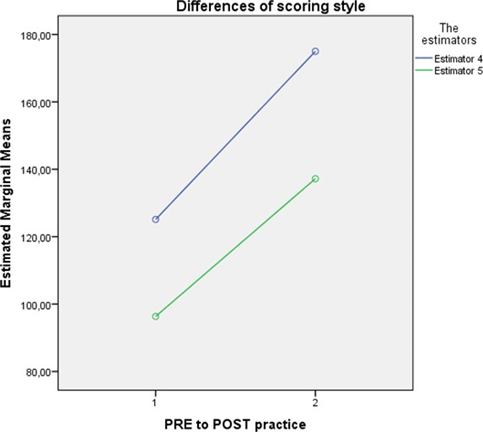
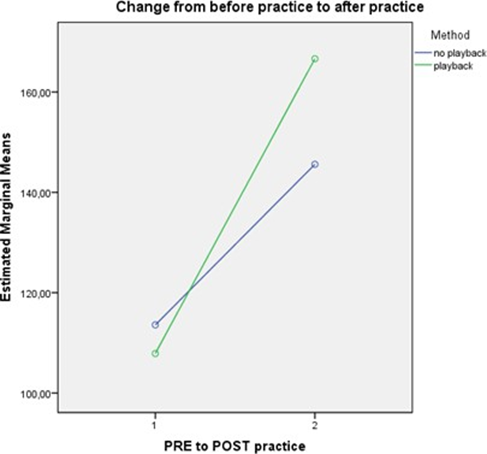
There were differences after the practice period between the study groups in learning the performance as a whole, the tempo and pulse, dynamics and phrasing, left hand and bowing technique, feeling and style of the music and communication skills (Fig. 2). The test group learned faster.
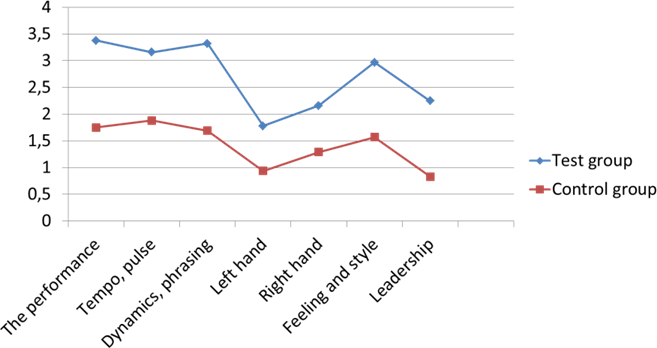
The aim of the recent study was to determine the potential of the Playback Orchestra method in learning a first violin score of a chamber music composition. As expected, on the basis of Juntunen`s (2011) earlier studies and experience and some cognitive research on learning music, the notation programme playback, as a kind of an auditory model, could call forth significantly faster improvement in the performance as a whole. Also in this study the performance of the test group were generally better and especially concerning the performing of tempo, dynamics, phrasing, left hand and right hand techniques, style and feeling and leadership (see Figure 3 and Table 1). There were a significant difference between the groups concerning communication (see Table 1) Furthermore, tonality-based intonation developed faster in the test group, probably due to the harmonic support of the playback and because the position and relaxation of the left hand in the playback group was a bit better right from the beginning (see Table 1).
At first, most of the scores of the playback group of students were lower than the scores of the non-playback students, which may reveal differences in learning strategy. Possibly the students in the playback group tried to catch the on-going music and play along, not so much trying to play it “right”. However, the scoring of the estimators was based on evaluating “correct” playing, precisely the way the music schoolteachers conventionally rate the performances of the students. Many skills that were better in the test group right from the beginning were connected with communication. Learning communication skills is important concerning a chamber music composition. Because the piece of music in this study was a first violin part, the ability to conduct a group by playing was crucial. Statistical analysis of the sum of communication variables pointed out that the test group improved faster than the control group in a highly significant amount (p=.006). It is clear that communication skills developed faster in the playback group of students.
Conclusions
To participate in an orchestra is to learn a lifestyle. Players work together with peers, learn to appreciate their work by practising their parts properly, listening to their playing and consenting to the rules and discipline. An orchestra student’s capacities are developed through continuous participation in authentic activities orchestra rehearsals are necessary, but home practice is required as well.
The Playback Orchestra method is like being in a virtual orchestra rehearsal, a virtual reality that allows active participation (Winn & Bricken, 1992). The method is not only a series of elements to be learned, as is the case in traditional learning designs based on reading from print, it is also a rather coherent virtual “space” similar to that mentioned in Harper et al. (2000).
In practising supported by the playback, the playing movements of the player are “time-scheduled” from the beginning, partly as a result of the “intro” in the playback. In addition, hearing the rhythm throughout the passage supports learning (Schellenberg, 1985). This may induce the appropriate quality of movements and gestures, which is the basis of skills for leading a group by playing.
Because the number of the students in the study was small (10), the results of this study cannot be widely generalized. More accurate research with a large number of tested students should be run.
Based on this study and Juntunen`s experience during ten years of orchestra teaching with the Playback Orchestra method, we can say that home practice programmes with auditory background as a support could increase motivation and contribute good quality and expertise in playing and playing together. Furthremore, they give joy to practising even tedious and monotonous second violin, viola or violoncello orchestra parts. Playing at home with a nice orchestra background could bring the family and the peers of a music student into the wonderful world of togetherness in orchestra life and practising.
Acknowledgements
The author(s) declare that there is no conflict of interest.
References
Csiksentmihalyi, M. (1996). Creativity. Flow and Psychology of discovery and Invention. New York: Harper Collins Publishers
Cunningham, D., Duffy, T. M., & Knuth, R. (1993). Textbook on the future. In C. McKnight. Hypertext: A psychological perspective (pp. 19-49). London: Ellis Horwood.
Duffy, T. M., & Cunningham, D. J. (1996). Constructivism: implications for the design and delivery of instruction. In D. H. Jonassen (Ed.), Handbook of research for educational communications and technology (pp. 170-198). New York: Macmillan Library Reference USA.
Elliott, D. J. (1995). Music matters. A new philosophy of music education. New York: Oxford University Press.
Galwey, N. W. (2006). Introduction to Mixed Modeling: Beyond Regression and Analysis of Variance. San Francisco: John Wiley & Sons. DOI:
Graham, S., & Weiner, B. (1996). Theories and principles of motivation. In D.C. Berliner & R.C. Calfee (Eds.), Handbook of educational psychology. New York: Simon & Schuster Macmillan, 63–84.
Harper, B., Hedberg, J. G., & Wright, R. (2000). Who benefits from Virtuality? Computers & Education, 34, 163- 176. DOI:
Heikkinen, M-H. (1995). Nina Svetlanovan pianopedagogiset perusideat: soivan mielikuvan, mentaalin harjoittelun, analyysin ja liikkeen tietoisen ennakoinnin merkitys harjoitteluprosessissa [The basic ideas in the piano pedagogy of Nina Svetlanova: the significange of auditory image, mental practice, analysis and conscious anticipation of movements]. Master’s thesis. Helsinki: Sibelius-Akatemia.
Jonassen, D. H. (1994). Thinking technology: toward a constructivist design model. Educational Technology, 34(3), 34-37.
Juntunen, P., Ruismäki, H., & Ruokonen, I. (2011). Music Technology in Finnish String Instrument and Orchestra Instruction. 4th International Journal of Intercultural Arts Education: Design Learning and Well-Being. University of Helsinki, Faculty of Behavioural Sciences, Department of Teacher Education. Research report 331 (pp. 97-114). Helsinki: Unigrafia.
Juntunen, P. (2011). Music Technology Promoting Violin and String Orchestra Instruction. Interdisciplinary Journal of Music and Art Pedagogy, 3, 17-34.
Karma, K. (1986). Musiikkipsykologian perusteet [Basics of Music Psychology]. Helsinki: Suomen Musiikkitieteellinen Seura.
Nakagava, S. (2004). A farewell to Bonferroni: the problems of statistical power and publication bias. Behavioral Ecology, 15(6), 1044–1045. DOI:
Kodaly, Z. (1974). The selected writings of Zoltan Kodály. London: Boosey & Hawkes Music Publisher Ltd. Pembrook, R.G & Taylor, J.A. (1986). Relationships between scores on a melodic discrimination test and the background variables of prospective music students. Bulletin of the Council for Research in Music Education 88, 1– 21.
Rideout, R. R. (1992). The role of mental presets in skill acquisition. In R. Colwell (Ed.), Handbook of research on music teaching and learning (pp. 472-479). New York: Schirmer Books.
Rosenthal, R., Wilson, M., Evans, M., & Greenwalt, L. (1988). Effects of different practice conditions on advanced instrumentalists' performance accuracy. Journal of Research in Music Education, 36(4), 250–257. DOI:
Sava, I. (1993). Taiteellinen oppimisprosessi. [Artistic Learning Process]. In I. Porna & P. Väyrynen (Eds.), Taiteen perusopetuksen käsikirja (pp. 15-34). Helsinki: Suomen kuntaliitto.
Schank, R. C., & Cleary, C. (1995). Engines for Education. Hillsdale, New Jersey: Lawrence Erlbaum.
Schellenberg, S. (1985). The effect of tonal-rhythmic context on short-term memory of rhythmic and melodic sequences. In Bulletin of the Council of Research in Music Education, 85, 207–217.
Sloboda, J. A. (1985). The musical mind. The cognitive psychology of music. Oxford: Clarendon Press.
Vartiainen, O. (1995). Orkesterisoitto musiikkiopistoissa [Orchestra Learning in Music Schools.] Master’s thesis. Helsinki: Sibelius-Akatemia.
Winn, W., & Bricken, W. (1992). Designing virtual worlds for use in mathematics education: the example of experiential algebra. Educational Technology, 32(12), 12-19.
Walters, D. L. (1992). Sequencing for efficient learning. In R. Colwell (Ed.), Handbook of research on music teaching and learning (pp. 535-545). New York, NY: Schirmer Books.
Copyright information

This work is licensed under a Creative Commons Attribution-NonCommercial-NoDerivatives 4.0 International License.

